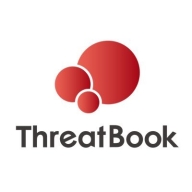

GitGuardian Public Monitoring and ThreatBook compete in the cybersecurity domain. ThreatBook is favored for its comprehensive feature set, though GitGuardian has an edge in pricing and support.
Features: GitGuardian offers real-time detection of exposed credentials, leverages advanced algorithms, and focuses on code security. ThreatBook prioritizes threat intelligence with data analytics, predictive threat modeling, and extensive threat analysis capabilities.
Ease of Deployment and Customer Service: GitGuardian emphasizes seamless integration and customer-friendly support with prompt assistance. ThreatBook involves a complex deployment process but offers robust guidance and technical support services.
Pricing and ROI: GitGuardian is cost-effective with rapid ROI, appealing to organizations seeking immediate security without significant financial investment. ThreatBook offers substantial long-term ROI despite higher initial costs, driven by its advanced threat management capabilities.

GitGuardian Public Monitoring allows real-time GitHub scanning and alerting to uncover sensitive company information hiding in online repositories. It monitors both organization repositories and developers' personal repositories. The solution gives visibility to developers and security teams on this very critical blindspot that are the organization developers' personal repositories on GitHub (80% of leaked corporate secrets on public GitHub come from developers’ personal repositories).
GitGuardian Public Monitoring is particularly interesting for companies with large development teams (above 200 developers) and modern development practices.
GitGuardian Public Monitoring cover 350+ API providers, database connection strings, private keys, certificates, usernames and passwords and intellectual property. It uses sophisticated pattern matching techniques to detect credentials that cannot be strictly defined with a distinctive pattern (like unprefixed credentials). The algorithm has a high precision (91% “true positive” feedback following our alerts, as reported by our users.)
The alerting is done in real-time (a few seconds after the secret was publicly exposed) which allows fast remediation involving in a collaborative way developers, security teams and operations.
GitGuardian Public Monitoring also allows red teams and pentesters to proactively look for sensitive information by performing complex queries on 12 billion documents and metadata from more than 3 years of GitHub history.
GitGuardian Public Monitoring scans public GitHub activity in real-time, helping organizations detect sensitive information leaks in source code repositories. Our solution gives Threat Intelligence and Security teams full visibility over their organization’s public GitHub Attack Surface, by monitoring both organization-owned repositories and developers' personal repositories.
With 80% of secrets and credentials leaks on public GitHub finding their source in developers' personal repositories, GitGuardian for Public Monitoring helps organizations address a critical security blind spot.
With real-time incident notification, Threat Intelligence and Security teams are guaranteed to reach the incident scene before everyone else and take action to mitigate the threat of breaches and intrusions.
ThreatBook is a cybersecurity platform that provides advanced threat intelligence to protect networks from evolving threats, utilizing real-time data analytics and comprehensive reporting to bolster defenses.
Designed for enterprises, ThreatBook equips IT teams with insights into the latest threats, integrating seamlessly with existing security infrastructures. It focuses on proactive threat detection and incident response, offering a deep understanding of threat landscapes. The platform is appreciated for its ability to deliver actionable intelligence, enhancing overall network security posture.
What are the key features of ThreatBook?In finance, ThreatBook implementation helps safeguard sensitive financial data, while in healthcare it protects patient information by preventing data breaches. It also supports manufacturing businesses by securing intellectual property from cyber espionage. Each industry benefits from features tailored to its specific threat landscape and priorities.
We monitor all Threat Intelligence Platforms reviews to prevent fraudulent reviews and keep review quality high. We do not post reviews by company employees or direct competitors. We validate each review for authenticity via cross-reference with LinkedIn, and personal follow-up with the reviewer when necessary.